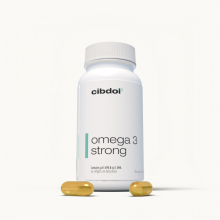Which Omega is Best for Muscle Growth?
Published:
For those looking to maximize muscle mass gains, nutrition is just as important as your training program. Getting adequate protein is crucial, but less discussed is the role essential fats like omega fatty acids play in supporting muscle growth. This article will explore which type of omega is optimal for building muscle.
Contents:
- An Overview of Omega Fatty Acids
- Muscle Protein Synthesis
- Hormonal Response
- Performance Metrics
- Inflammation and Muscle Recovery
- Overall Results on Muscle Growth
- Additional Evidence for EPA and Muscle Growth
- Anti-Inflammatory Benefits Beyond Muscle Growth
- Optimizing Total Nutrition for Muscle Growth
- Conclusion
We’ll compare the evidence on the three main omega fats – ALA, DHA, and EPA – and analyze which has the strongest effects for muscle protein synthesis, performance, hormonal response, and overall hypertrophy. Let’s dive in.

An Overview of Omega Fatty Acids
Before determining which omega stands above the rest for muscle building, let’s first provide context by defining what exactly the omega fats are and their general health benefits:
The 3 Main Types of Omegas
There are three primary omega fatty acids that the body requires:
- ALA (Alpha-Linolenic Acid) – An essential omega-3 fat found in plant foods like flaxseeds, chia seeds, walnuts, and Brussels sprouts
- DHA (Docosahexaenoic Acid) – An essential omega-3 fat abundant in fatty fish and fish oil supplements
- EPA (Eicosapentaenoic Acid) – Another essential omega-3 fat concentrated in seafood and supplements
ALA is the only omega-3 obtained from plants, while DHA and EPA come from animal seafood sources.
Essential for Health
These omegas are termed “essential” because the body cannot produce them on its own. We must obtain them from dietary sources for proper health and development.
They are critical for cell membrane structure and function, brain growth and performance, visual acuity, fetal development, and reducing inflammation.
Powerful Anti-Inflammatory Effects
A major reason the omega-3 fats EPA and DHA provide health benefits is their ability to resolve inflammation throughout the body. They help counterbalance the pro-inflammatory omega-6 fats overabundant in modern diets.
Now that you understand the basics of what the omegas are, let’s analyze how they compare for supporting muscle growth.
Muscle Protein Synthesis
The process of building new muscle, known as muscle protein synthesis, is stimulated by resistance training workouts. Consuming adequate protein from food sources or supplements after training further amplifies this effect.
But could essential fats like the omegas also play a role in activating muscle protein synthesis (MPS)? Let’s see what the science says.
DHA
Several rodent studies report increases in MPS rates and levels of anabolic signaling proteins like mTOR and p70S6K when supplemental DHA from fish oil is provided. However, direct human data is lacking.
EPA
In older adults, providing EPA supplements for 8 weeks increased MPS rates by over 30%. EPA also lowered muscle protein breakdown markers. The effects were enhanced when coupled with protein intake.
ALA
There is limited evidence that ALA influences muscle protein synthesis. Any benefits are likely derived only after conversion to EPA. But this conversion is inefficient, with less than 5-10% converting.
Winner: EPA
Overall, EPA has the most human data supporting direct activation of muscle protein synthesis. DHA is a close second, while ALA lacks sufficient evidence.
Hormonal Response
In addition to MPS, optimizing the body’s hormonal environment is key for maximizing muscle growth from training. Do any of the omegas influence anabolic hormones?
DHA
A DHA supplement provided immediately after weight training increased growth hormone release by over 100% compared to placebo in young athletes. However, this is the only study for DHA, so more data is needed.
EPA
Several trials show EPA combined with strength training boosts testosterone levels and anabolic growth factors like IGF-1 compared to training alone. The synergistic effect is consistent and significant.
ALA
There is very limited evidence that ALA positively influences anabolic hormones like testosterone. Any benefits are again likely dependent on conversion to EPA and DHA.
Winner: EPA
For beneficially altering the body’s hormonal milieu in response to training for greater hypertrophy, EPA again appears most promising. More data on DHA is warranted.
Performance Metrics
In addition to muscle protein synthesis and hormones, we also want to examine if any of the omegas improve performance metrics like strength, endurance, power output, and perceived exertion.
DHA
A few studies report lower perceived exertion and fatigue in athletes supplementing with DHA. Improved blood flow may play a role. But there is little evidence of direct performance enhancement thus far.
EPA
Numerous studies find EPA supplementation improves strength gains, anaerobic power output, and perceived exertion when coupled with regular training. Effects are particularly notable at higher doses above 2 grams.
ALA
Very sparse data exists demonstrating ALA improves exercise performance metrics like strength and power. Any benefits are dependent on conversion to EPA and DHA.
Winner: EPA
For boosting measurable metrics like strength gains, power output, and perceived exertion, EPA supplementation again appears most beneficial for performance.
Inflammation and Muscle Recovery
Managing inflammation and accelerating workout recovery are also important factors for optimal muscle gains. Do any of the omegas demonstrate benefits here?
DHA
A few studies report reductions in inflammatory markers like C-reactive protein when supplementing with DHA. Effects were moderate and need more substantiation.
EPA
Robust data shows EPA consistently decreases inflammatory cytokines, lowers post-exercise soreness, and attenuates muscle protein breakdown after resistance training sessions.
ALA
There is limited evidence that ALA supplementation alone eases workout soreness or accelerates recovery. Any benefits likely require conversion to EPA.
Winner: EPA
For curbing excessive inflammation and speeding workout recovery, EPA is superior to DHA or ALA based on the collective research data available.
Overall Results on Muscle Growth
Now that we’ve analyzed the evidence in all relevant categories, which omega fatty acid stands above the rest when it comes to supporting muscle hypertrophy and growth?
DHA
Has some promising data on mTOR stimulation, growth hormone response, perceived exertion, and blood flow. But human trials are sparse. Enhancing effects may require combination with EPA.
ALA
Very limited evidence it directly stimulates muscle growth. Any benefits likely rely on inefficient conversion to EPA and DHA. Not a good choice for boosting hypertrophy.
EPA
By far the most clinical data showing direct stimulation of MPS, amplification of anabolic hormones, reductions in muscle protein breakdown, and performance enhancement.
The Verdict
EPA wins by unanimous decision. For all aspects of promoting muscle growth – including protein synthesis, hormonal response, performance, and recovery – EPA has the most robust scientific backing.
The collective research supports supplementing with at least 2-3 grams of EPA daily from fish oil or other pure, third-party tested sources for maximizing gym gains. Combining with 0.5-1 gram of DHA may provide further synergistic effects.
Additional Evidence for EPA and Muscle Growth
In addition to the mechanistic categories covered earlier, there are also several direct clinical studies showing EPA enhances muscle growth in those performing resistance training:
- Soccer players taking EPA/DHA for 5 weeks gained more lean muscle and lost more fat following a concurrent training program compared to placebo group.
- Untrained young men taking 4 grams of EPA/DHA daily experienced significantly greater muscle mass gains doing resistance training for 6 weeks versus training alone.
- Elite rugby athletes had greater muscle thickness increases measured via ultrasound when supplementing with EPA and whey protein compared to whey protein alone over 8 weeks.
- Multiple other trials confirm EPA enhances lean tissue accruement and muscle strength and size gains when combined with progressive overload weight training protocols.
The collective body of evidence overwhelmingly supports EPA as the star omega-3 player for augmenting muscle growth and performance. Anyone looking to maximize their training results should strongly consider supplementing with purified EPA sources like fish oil.
Anti-Inflammatory Benefits Beyond Muscle Growth
While EPA is the champ omega for building muscle, it provides a multitude of other health benefits as well due to its powerful anti-inflammatory effects. Some of these include:
Brain Health
EPA helps resolve inflammation in the brain that can impair cognition. It may improve focus, memory, mood, and depression. The anti-inflammatory effects likely underlie these mental benefits.
Heart Health
Chronic inflammation contributes to atherosclerosis and cardiovascular disease progression. EPA helps reduce vascular inflammation for better heart health.
Joint Health
Inflammation causes degeneration of joints and cartilage over time leading to arthritis. EPA can help curb inflammatory cytokines like IL-6 that are often elevated with joint issues.
Skin Health
Inflammatory skin conditions like eczema, psoriasis, and acne may improve with EPA by reducing inflammatory reactions. This can support skin healing.
So in addition to building muscle, EPA offers widespread anti-inflammatory benefits for overall health and wellness. Prioritizing this omega-3 should be on everyone’s list.
Optimizing Total Nutrition for Muscle Growth
While this article focused specifically on the benefits of EPA for muscle building, it’s important to remember your overall nutrition program plays a much bigger role than any single supplement.
Here are some key dietary strategies to maximize muscle growth:
- Get sufficient total calorie intake to support muscle gains. Aim for a modest surplus of around 10%.
- Prioritize high protein intake from lean meats, dairy, eggs, and protein powders. Shoot for 0.7 – 1 gram per pound of bodyweight.
- Time protein intake around workouts to amplify muscle protein synthesis. Have a fast digesting source like whey right after training.
- Consume mixed meals with protein, carbs, and healthy fats for sustained nutrition.
- Fill in the rest of calories from fruits, vegetables, whole grains, nuts, seeds, and healthy fats like olive oil.
- Stay well hydrated with water and limit intake of sugar sweetened beverages.
While EPA can provide an edge, you must first get the dietary basics right. No supplement can out-train or out-eat a poor diet. Optimize nutrition, train hard, and then consider EPA for that additional push.
Conclusion
To maximize muscle building from resistance training, the omega fatty acid EPA clearly stands above the rest. The collective body of evidence shows EPA:
- Stimulates muscle protein synthesis
- Amplifies anabolic hormone levels
- Reduces muscle protein breakdown
- Improves performance metrics like strength and power
- Speeds workout recovery
When combined with a progressive overload training program and a nutrition plan emphasizing sufficient calories, protein, and micronutrients, supplementing with ~2-3 grams of purified EPA can provide a significant edge for boosting lean muscle mass accrual.
DHA may offer some synergistic benefits, but EPA appears most critical. ALA requires conversion to EPA/DHA for any muscle supporting effects.
While a well-rounded nutrition program remains most important, optimizing intake of the omega-3 fat EPA can give that additional push for taking your training and physique to the next level.










